Order these records by:
Browse Collection › LC Subject Heading › 7 records found where LC Subject Heading is African Americans -- North Carolina -- Social life and customs -- 20th century | ||
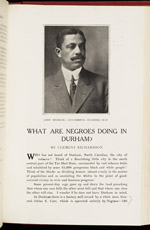 | What are Negroes doing in Durham? Essay by Clement Richardson in the Southern Workman highlighting the achievements of the African American community in Durham in the early 1910s. Richardson focuses on the contributions of black entrepreneurs and professionals including E. R. Merrick, Robert Fitzgerald, Stuart Lynn Warren, John Merrick, Dr. A. M. (Aaron McDuffie), R. H. Clegg, W. G. Pearson, J. S. Scarborough, E. W. Cannady, Dr. F. D. Page, Peyton H. Smith, P. W. Dawkins, Jr. and others. | |
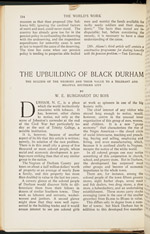 | Upbuilding of black Durham: the success of the Negroes and their value to a tolerant and helpful southern city Essay by W. E. B. DuBois in the World's Work reporting on his visit to Durham, North Carolina in 1912. DuBois analyzes the economic culture and explores the history of race relations in this southern city. DuBois provides a history of black enterprises and educational institutions that served the black community in Durham. The article features photographs of R.B. Fitzgerald, C.C. Spaulding, White Rock Baptist Church, North Carolina Mutual Insurance Company and a view of workers in a black-owned hosiery manufacturing company. | |
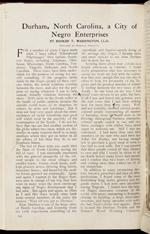 | Durham, North Carolina, a city of Negro enterprises Booker T. Washington, principal of Tuskegee Institute, penned this essay in 1911 for the illustrated magazine, Independent. Washington, recounts his travels to Durham and gives his observations about race relations in Durham. Washington discusses the economic and cultural contributions of many prominent members of the African American community including: Richard B. Fitzgerald, Aaron M. Moore, Richard E. Clegg, John Merrick, and Charles Clinton Spaulding. He devotes much of his analysis to the economic development of the black community in a place that he dubbed, “City of Negro Enterprises.” | |
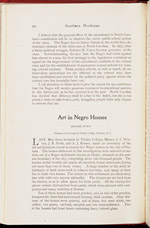 | Art in Negro homes Essay by Trinity College professor Jerome Dowd (1864-1952) describing a survey made by three Trinity College students in the early 1900s of the interiors and exteriors of 25 homes in Hayti, a largely African American community in Durham, North Carolina. The article enumerates the material cultural artifacts--decorative art, carpets, and furnishings--in these homes as well as the titles of books, magazines and newspapers. | |
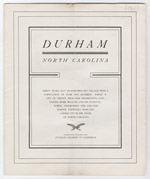 | Durham, North Carolina : thirty years ago an insignificant village with a population of some five hundred A Durham Chamber of Commerce booklet, published in 1906, which presents a short history of Durham as well as numerous photographic illustrations of educational institutions, churches, manufacturing establishments and street scenes. The pamphlet also includes statistical information about Durham County and its schools. | |
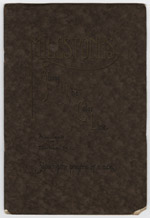 | Milestones along the color line. A souvenir of Durham, North Carolina showing the progress of a race Oliver B.Quick created Milestones Along the Color Line. A Souvenir of Durham, North Carolina Showing the Progress of a Race, to show property “owned and controlled exclusively by Negroes in the city of Durham, N.C.” In his preface he noted, “we have selected these [institutions and homes] as evidence of the progress being made by our race group in this section of the South.” The pamphlet contains numerous photographic images of churches, schools, business establishments, private residences and street scenes. | |
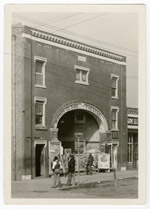 | Photograph of Wonderland Theater in Durham Photograph of the Wonderland Theater, located on the corner of Pettigrew and Ramsey streets. This theater, owned by "movie king" Frederick K. Watkins offered entertainment for Durham's black residents. A poster advertises The Barrier, starring Lionel Barrymore. | |
digitaldurham@duke.edu · About this site · Copyright © 2001 - 2006. Trudi J. Abel. All Rights Reserved.
The copyright interest in the material in this digital collection has not been transferred to the Digital Durham project. These text and images may not be used for any commercial purpose without the permission of the David M. Rubenstein Rare Book & Manuscript Library and the Digital Durham Project. Copyright permission for subsequent uses is the responsibility of the user.
